2009 VOLKSWAGEN GOLF brake light
[x] Cancel search: brake lightPage 279 of 516
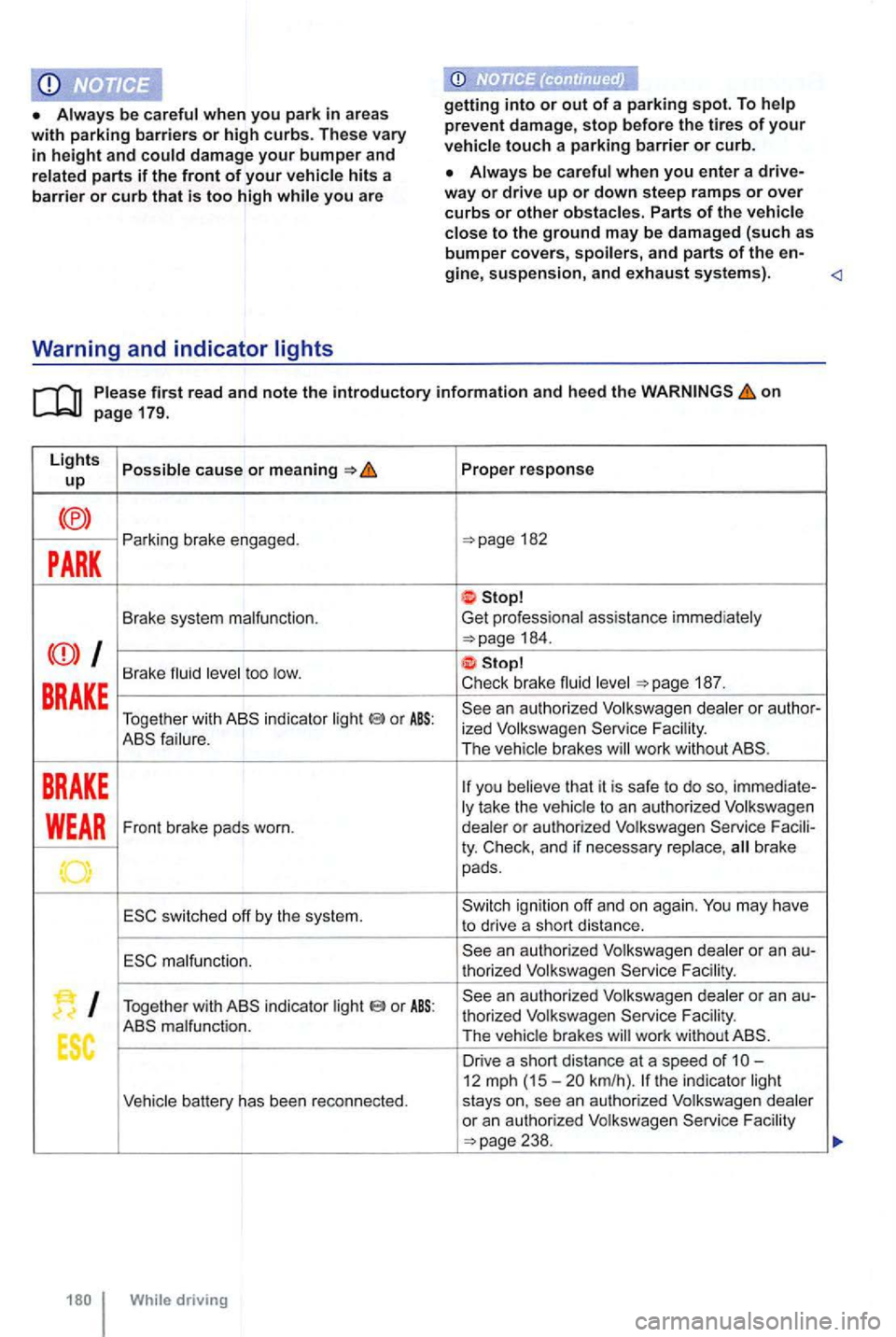
you are
prevent dam age, stop before the tires of yo u r
v ehicle touc h a parking bar rier or curb.
on page 179.
Lights
Possible cause or me aning Prope r re s ponse up
<®> Parking brake engaged.
Brake fluid too Check brake
or ABS: ized Volkswagen failure.
The brakes wor k withou t
BRAKE
Facili-ty. Check, and if necessary replace. brake pads.
switc hed off by the system.
malf unction . an aut horized Volkswage n deale r or an au-
thorized Volkswagen Facility .
Together with or ABS : Facility. malfunction.
The vehic le brakes
Driv e a s hort distance at a speed of 1 -
12 mph (15-km/ h). th e indicator light battery has been reconnect ed. stays see
an authorized Volkswagen dealer or an authorized Volkswagen 238.
Page 280 of 516
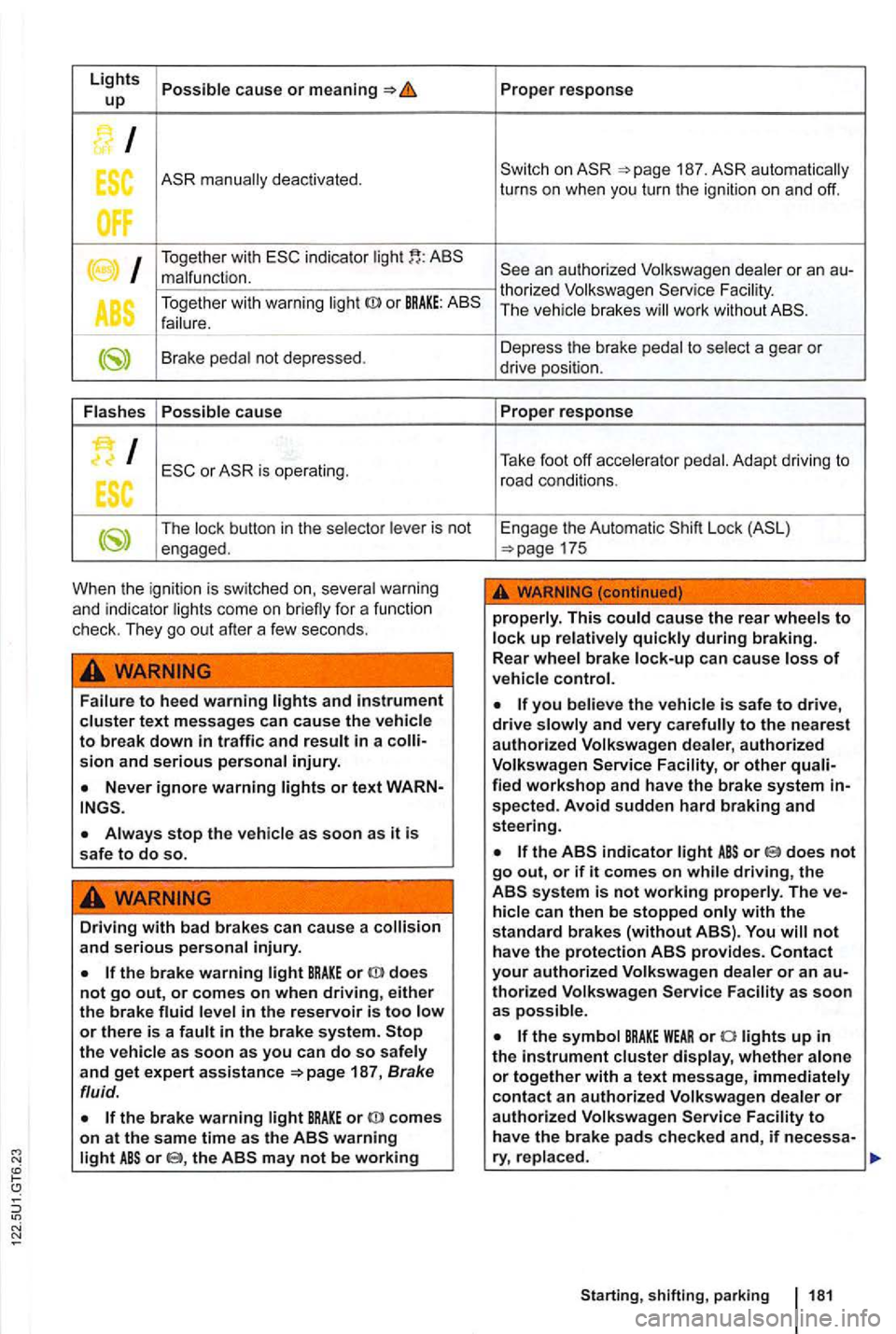
Lights cause or up
I
ES deactivated.
I Together with indicator malfunction .
T ogethe r with warning
or BRAKE:
Brake not dep ressed.
cause
I
The butt on in the is not
engaged .
When the ign ition is switch ed on,
text messages can cause the to break down in traffic and
or text WARN
stop the as soon as it is safe to do so.
Driving with bad brakes can cause a and serious
the brake warning BRAKE or does not go out, or comes on when driving, either the brake or there is a the as soon as you can do so and get expert assistance 187, Brake
fluid.
the brake warning comes on at the same time as the or the
187 . automatically
turns on when you turn the ignition on and off.
an authorized Volkswagen or an thorized Volkswage n The brake s work without
to
Adapt driving to
road conditions.
E ngage the Automatic
Lock
This up brake
you is safe to drive, drive and very authorized Volkswagen Service or other
spected. Avoid sudden hard braking and steering.
or does not go out, or if it comes on while driving, the system is not working can then be stopped with the
s tandard brakes (without not have the protection
thorized Volkswagen Service as soon as
Starting, shifting, parki ng 181
Page 281 of 516

Failure to heed warning lights or t ex t WARN-can result in vehicle damage .
Fig. 113 Between the front seats :
on page 179.
the parking brake lever up firmly.
When the ignition is on , the indicator or appears in the instrume nt c luster display to show th at the park ing brake is engaged
the leve r up 113 (arrow) .
While hold ing the release button down, move
t h e lever t he way down.
Parking
Ple ase firs t r ea d and note the introductory info rm ation and heed the WARNon pa ge 179.
note legal regulations when stopping and
parking your vehicle.
Parking the vehicle
p erform these steps only in the order listed.
the vehicle on a suitab le surface
the rear wheels are braked . Always
use the foot bra ke.
engag ed. This c an cause the brak e to over
heat and neg ati vely affec t the b rak e sys te m .
start to move even if the parking brake is e ngag ed .
Even
though the tra nsmission is in P ark (P),
t h e vehi cle may move a couple of inche s (a fe w
c entimeters) forwards or backwards if you take
your f oot off the brake pedal after stopping the
ve hicl e without fir s t firmly setting the parking
b rake .
A warning signal sounds if you drive faster
Apply t he parking brake to 182.
For automatic transmissions : (P).
Remove the vehicle key from the igni tion.
necessary , turn the steer ing whee l to
e ngage the steer ing column lock.
Page 292 of 516
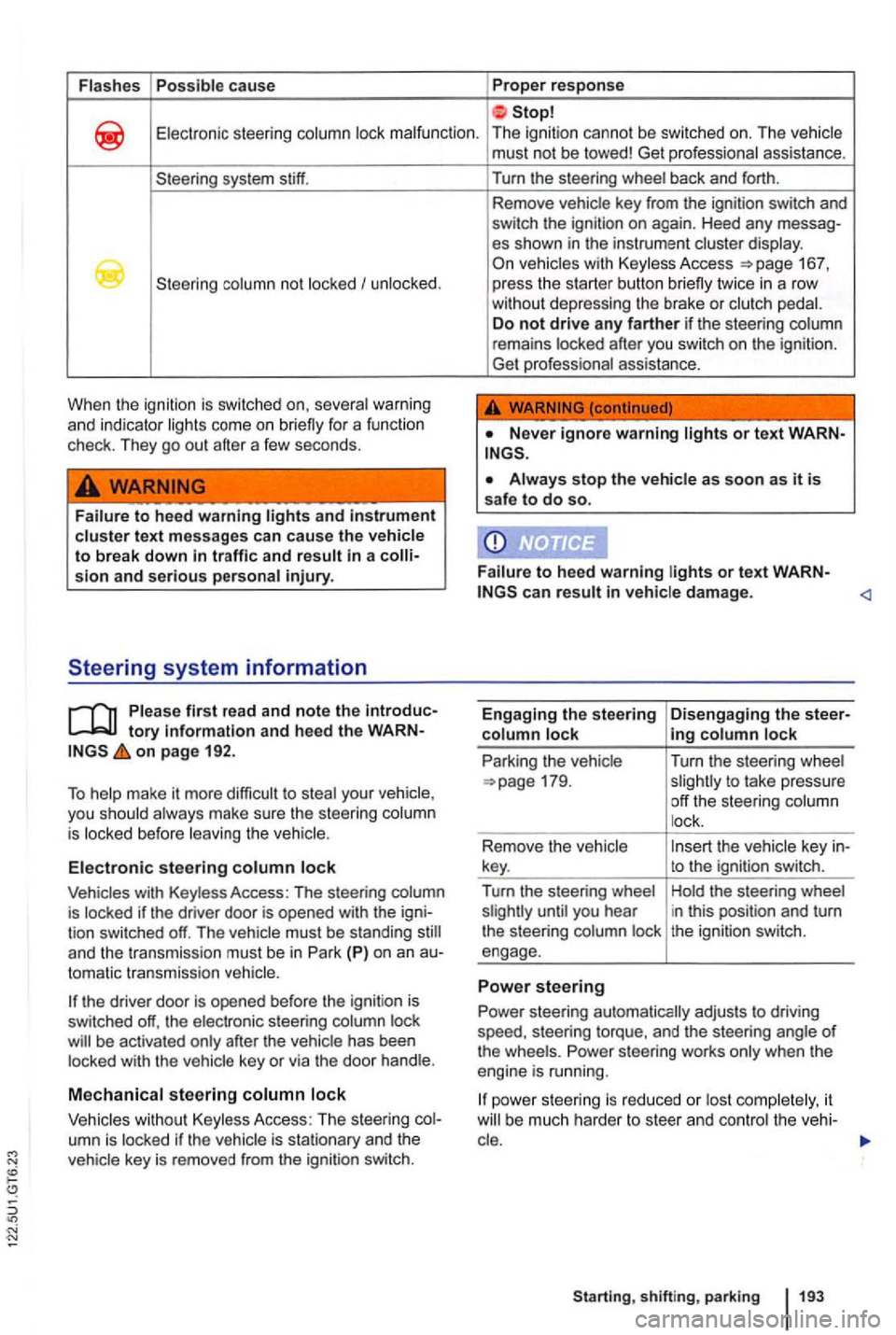
Flashes Possible ca use Proper response
Electronic steering column lock malfunction . The ignition cannot be switched on. The vehicle
system stiff.
column not locked I unlocked .
When the
ignition is switched severa l warni ng
a n d indicator lights come on briefly for a function
check . T hey go out after a few seconds.
Failure to heed warning lights and instrument cluster text messages can ca use the vehicle to break down sion and serious personal injury.
tory Information and heed the on page 192.
To
tomatic transmiss ion vehicle.
press the starter button briefly twice in a row
without depressing the brake or clutch pedal.
D o
not drive any farther if the steering column
remains locked after you switch on the ignition.
Get professional assistance.
Always stop the vehicle as soon as it is safe to do so.
F a
ilure to heed warning lights or text can resu lt vehicle damage .
Engaging the steering
co lumn lock
Park ing the vehicle
ing column lock
Turn the steering wheel
slightly to take pressure
off the steering column
l ock .
to the ignition switch.
Hold the steer ing wheel
i n this position and turn
the ignition switch.
Power steering automatically adjusts to driving
speed , steering torque, and the steering angle
of the wheels . Power steering works only when the
engine is running .
it
Sta rting, sh ift ing , park ing
Page 294 of 516
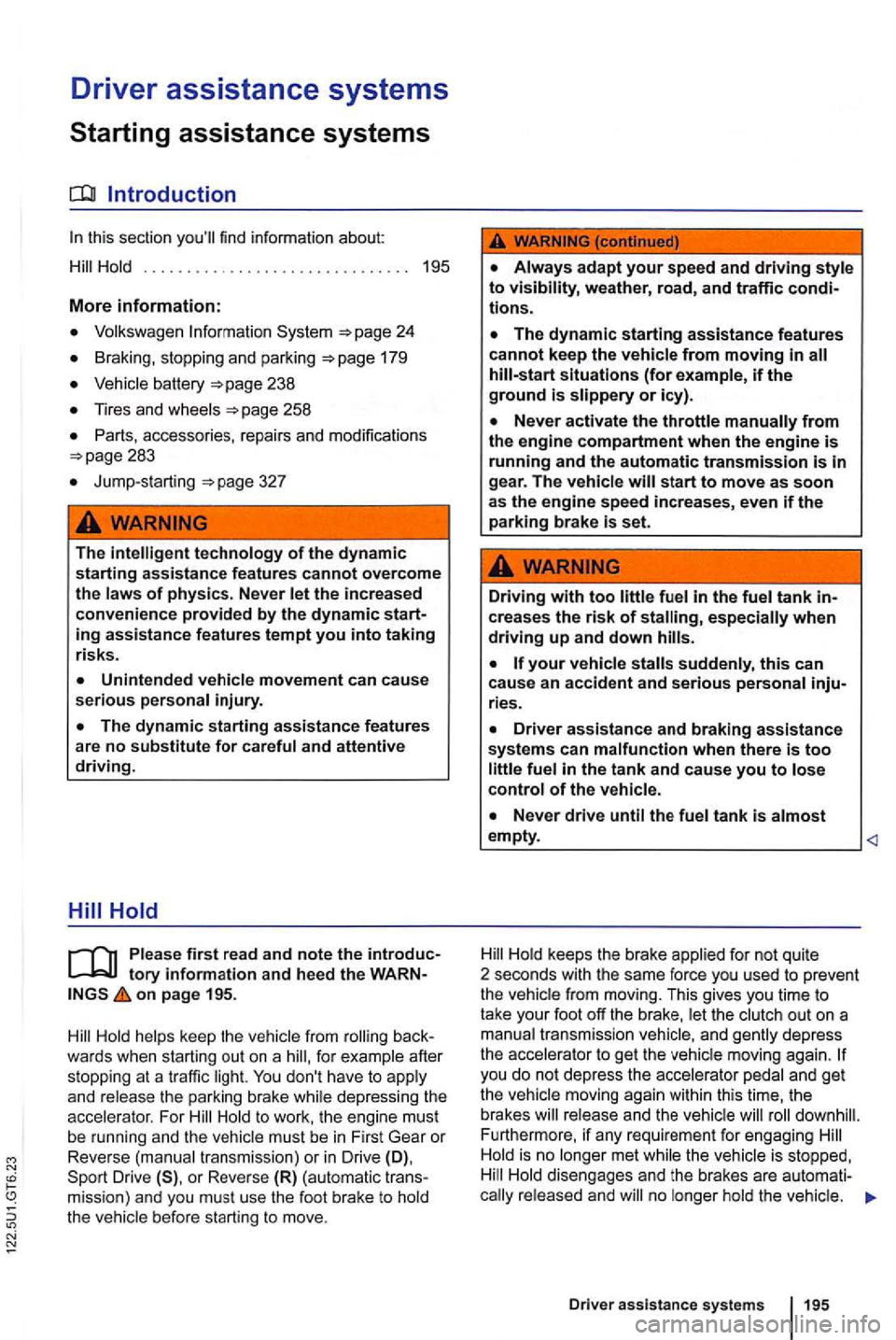
Driver assistance systems
Starting assistance systems
Volksw age n Informatio n pag e 24
pa ge 179
Vehicle batt ery
p age 2 58
Jump-s ta rting page 327
The
on p age 195 .
fo r examp le afte r
s topping at a traffic light. don't have to app ly
an d r elease th e park ing brake whil e depress ing the
accele ra tor . For
The dynam ic sta rting assistance feature s
cannot keep the vehicle from moving in all hill-start situations (for example, if the ground is slippery or icy).
Driving with too little fuel in the fuel tank in-
c rea se s th e risk of especially when driving up and down hills.
H old keeps th e bra ke a ppl ied for not quit e
2 seconds with the same force you u sed t o p reve nt the veh ic le f rom mov ing. This gives you time to
t ake your foot off the brake , let the clu tch out on a manual transm issio n veh ic le, a n d gently depress
the accele ra tor to get the veh icle m ovi ng agai n.
F urther more, if any requi remen t for engagi ng
Ho ld disengages and the brakes are automati no longer ho ld th e vehic le.
Driver ass is tance systems 195
Page 302 of 516
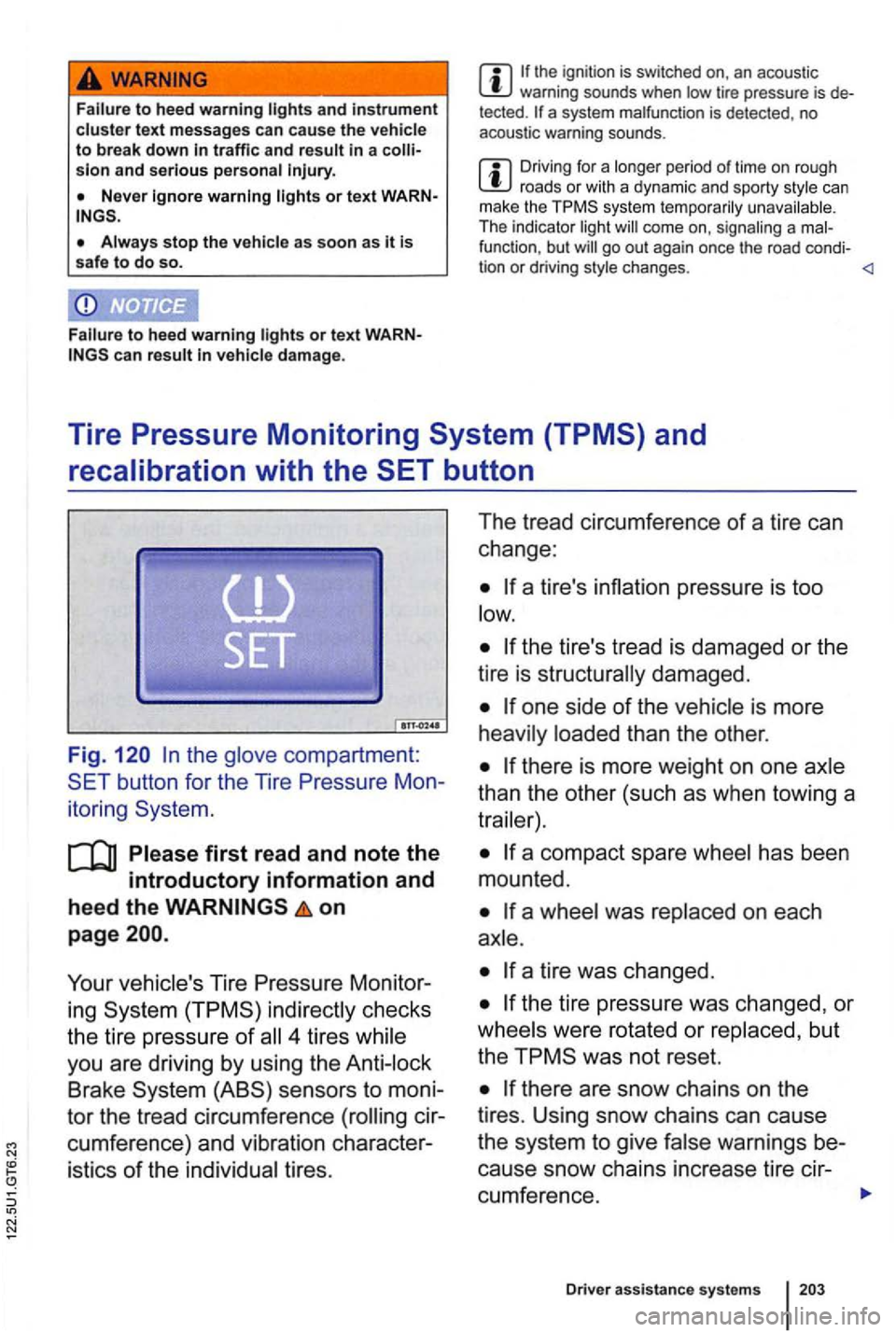
to heed warning and instrument text messages can cause the to break down traffic and sion and serious
or text
stop the as soon as it is
safe to do so.
or text can damage .
the ignition is switched on, an acous tic warning sounds when tir e pressure is tected. a system malfunc tion is detected , no
aco ust ic warn ing sounds .
Driving fo r a lon ge r period of tim e o n roug h roa ds or w ith a dynamic and sporty s tyle can
m ake th e system te mpora rily unavai lable .
Th e in dicato r light
fu nc tio n, b ut
Tire Pressure Monitoring
the
on
page
Your Tire Pressure Monitor
ing
4 tires
Brake
tires . The
tread circumference
of a tire can
change :
one side of the
than the other .
than the other (such as when towing a
has been
mounted .
a
a tire was changed.
the tire pressure was changed , or
were rotated or
was not reset.
warnings be
cause snow chains increase tire cir-
cumference.
Dri ver assistance syste m s
Page 322 of 516
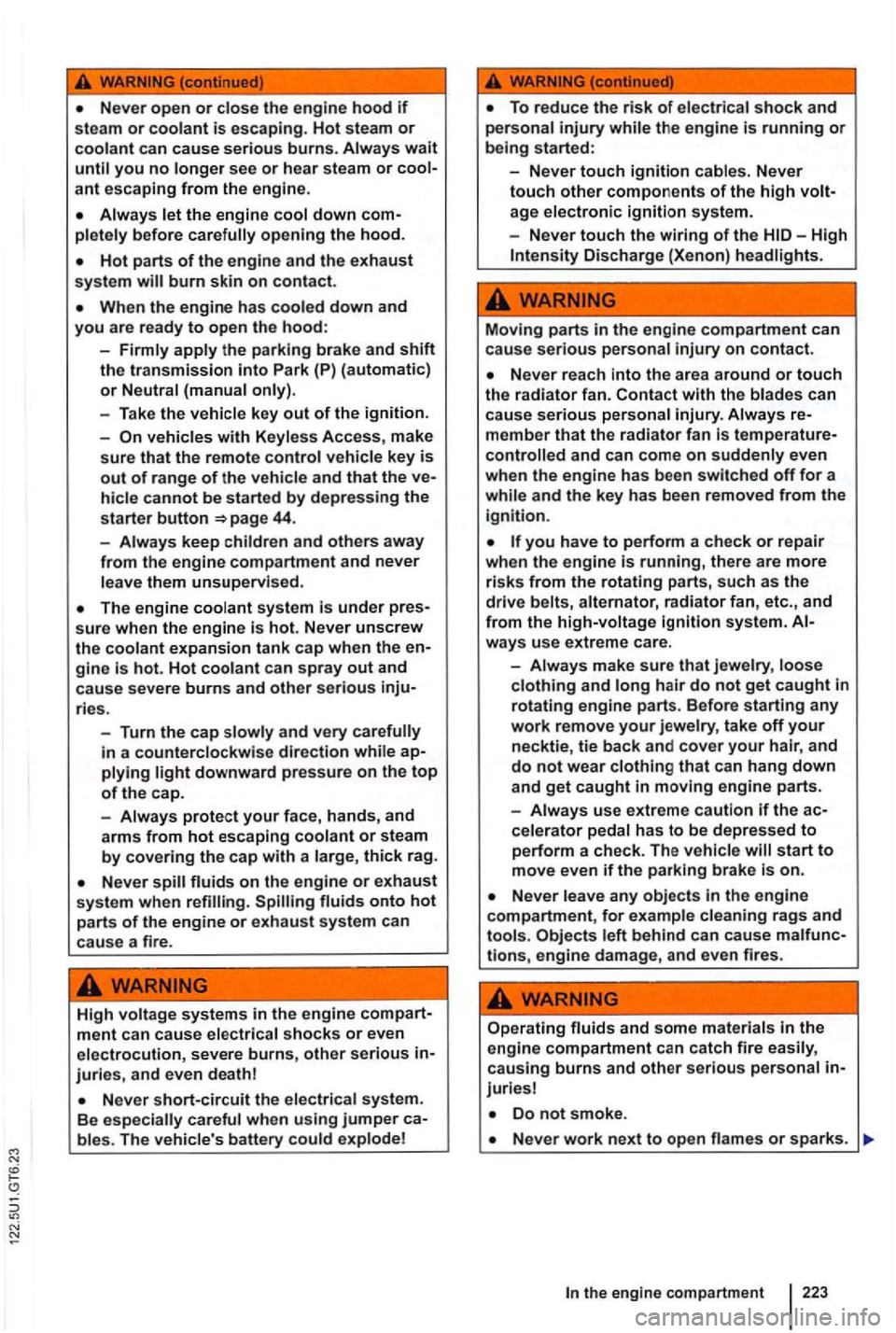
Never open or close the engine hood if To reduce th e risk of electrica l shock and steam or coolant is escaping. Hot steam or personal injury
-Never touch ignition cables. Never ant escaping from the engine. touch other components of the high
Always the eng ine down com-age electronic ignition syste m .
opening the hood.
-Never touch the wiring of the Discharge (Xenon) headlights.
system burn skin on contact.
you are read y to open the hood: Moving parts in th e engine compartment can
- Firm ly apply the parking brake a nd shift cause serious personal injury on contact. the transmission into Park (P) (automatic)
vehicles with Keyless Access, make member that the radiator fan is temperature-
s
ure that the remote contro l vehicle key is controlled and can come on sudden ly even
out of range of th e vehicle and that the ve- when the engine
has been switched off for a
hicl e cannot be started by depres sing the 44. ignition.
-
Always keep children and others away you have to perform a check or repair from the engine compartment and never when the engine is runn ing, there are more leave them unsupervised. risks from the rotating parts, such as the
hair do not get caught in
ries. rotating engine
parts. B efore starting an y
- Turn
the cap
fluids onto hot parts of the engine o r exhaust system can
cause a fire. -
Always use
extreme caution if the ac-
ce lerato r pedal has to be depressed to perform a check. The vehicle will start to move even if the parking brake i s on.
Never leave any objects in the engine compartment, for examp le cleaning rags and tools. Objects left b ehind can cause malfunc-lions, engine damage, and even fires.
High voltage sy stems in the engine com part-ment can ca use electrica l shocks or even
electrocution, severe burns, other serious in-juries, and eve n deathl
Neve r short-circuit the electrica l syste m .
B e especially ca reful when using jumper ca-
Operating fluids and some materials in the engi ne compartment can catch fire easily, causing burns an d other serious personal in-juries
Do not smoke .
b les. The
vehicle 's battery could exp lode! Never work next to open flames or sparks .
223
Page 343 of 516
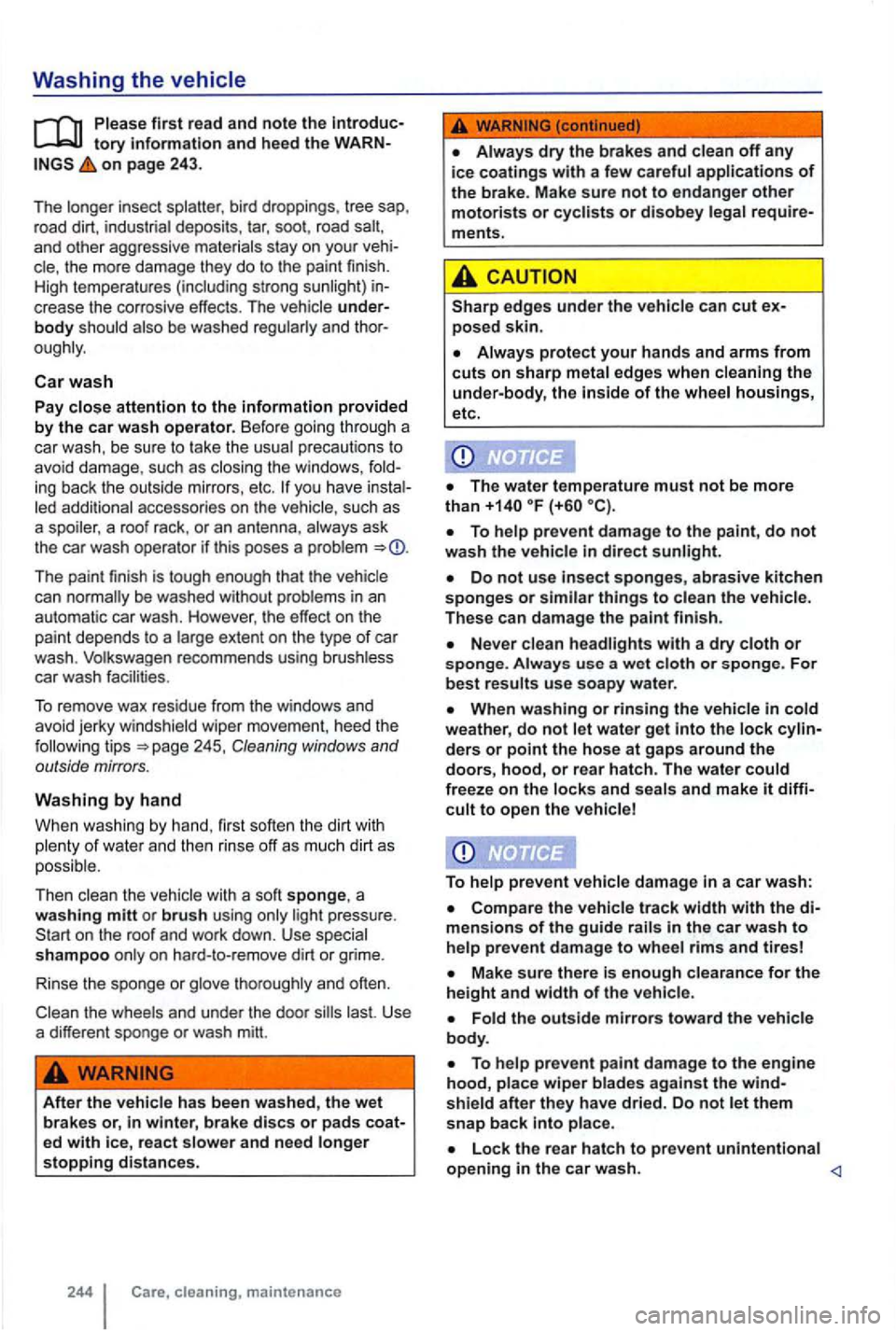
Washing the vehicle
tory information and heed the on page 243 .
T he longer insect splatter , bird droppings, tree sap,
r oad dirt , indust rial deposits , tar , soot , road
and othe r aggressive materials stay on your cle, the more damage they do to the paint finish.
H igh temperatures (includi ng strong sunlight)
oughly.
Car wash
Pay close attention to the information provided
by the car wash operator . B efo re goi ng throu gh a
ca r was h, b e s ure to take th e usual precautio ns t o
avoid damag e , such as closi ng the windows ,
The paint finish is toug h enough th at the vehicle can
the wheels and under the door
After the vehi cle ha s been washed , the wet brakes or, in winter, brake discs or pads ed with ice, react slower and need longer stopping distances .
WARNING
Always dry the brakes and clean off any ice coatings with a few careful applications of the brake . Make sure not to endanger other motorists or cyclists or disobey legal require-
ments .
edges under the vehicl e can cut ex-
posed skin.
Always protect your hands and arms from cuts on sharp metal edges when cleaning the under-body , the inside of the wheel housings,
etc.
The water temperature must not be more
than
Ne ver clean headlights with a dry cloth or sponge . Always use a w et cloth o r s ponge . For best result s use soapy water.
When washing or rinsing the vehicle in cold weather , do not
cult to open the vehicle!
To help prevent vehicle damage
in a car wash:
in the car wash to help prevent damage to wheel rims and tires!
Make sure there is enough clearance for the
height and width of the vehic le .
To help prevent paint damage to the engine
hood, place wiper blades against the shield after they have dried. Do not let them
snap back into place .
Lock the rear hatch to prevent unintentional
opening in the car wa sh .